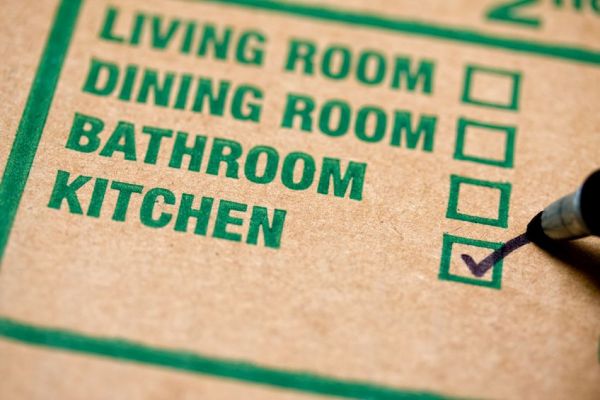Many people will have to downsize to a smaller home at some point in their lives, including your parents and grandparents. When it’s time to make this move, the best way to downsize seniors is to involve every party in the entire process as much as possible.
If you’re lucky, your parent(s), grandparent(s), or other seniors in your care will be open to the idea of downsizing from the beginning, or they may even bring it up themselves. Often, however, adjusting to the idea of downsizing—which often means moving out of a longtime home and into an unknown community—can take months or even years. It can also require input, support, and gentle nudging from key caregivers and other family members.
Sometimes your parents or grandparents are able to manage most of the transition themselves, from house hunting for a smaller home to decluttering and packing their belongings. Other times, the seniors in your life may be unable to handle the process on their own and will need more input from you, whether that’s a dispassionate eye to help decide whether something should go in the “keep” or “donate” pile or a firm nudge to help them realize their 2-story, 4-bedroom home is no longer serving their needs.
In our downsizing parents guide, we’ll share our expert advice for downsizing seniors from start to finish. Along with patience, understanding, and compassion, here are the supplies you’ll need to get started:
- Garbage and recycling bags
- Clear plastic bags for clothing and soft-good donations
- Stickers or sticky notes for labelling
- Cardboard boxes
- Packing tape
- Tape gun
- Black permanent markers
- Cushioning material of choice (packing peanuts, bubble wrap, newspaper, etc)
- Furniture dollies for heavy items
Once you’ve acquired the necessary supplies (physical or otherwise), follow the advice below to make the home downsizing process as painless as possible:
Start early
The process of downsizing seniors can be very emotional and is often a difficult topic to broach. Many people have a hard time facing that their life is changing or that they or their parents are getting older, but the best time to begin the downsizing process is actually well ahead of any planned move and when your parents are still in good health and mentally present. When you start the discussion early, you may find that your parents or siblings want to put it off, but you should push to start the downsizing process sooner rather than later, even if there isn’t a move on the table in the immediate future. The moving process is stressful enough without adding the task of decluttering decades’ worth of stuff into the mix.
Many experts, including Margareta Magnusson, author of The Gentle Art of Swedish Death Cleaning, recommend starting the downsizing process around age 65. This allows the downsizees to be active participants who are in control of the process, which can make it easier to decide what to do with belongings, as well as afford them the opportunity to share their memories and identify which objects are actually meaningful and should be kept.
For more advice, check out these books on the subject:
- The Gentle Art of Swedish Death Cleaning by Margareta Magnusson
- Let It Go by Peter Walsh
- The Life Changing Magic of Tidying-Up by Marie Kondo
- Downsizing the Family Home by Marni Jameson (also available as a workbook)
Begin with lesser-used spaces
If you and your parents are struggling with the immensity of the task of cleaning out decades worth of items, it is best to begin in little-used areas of the home that are typically reserved for storage, such as attics, basements, crawlspaces, laundry rooms, and cellars.
Identify what's really needed
Figure out which items are being used on a daily or regular basis, which seasonal items from storage are still of-use, and which must be kept for sentimental reasons. This process can help you quickly narrow down which items should be kept, and makes it easier to place things into the “maybe” or “get rid of” piles.
TSI TIP: The most important thing is to hold on to the items that your parent or parents really want in their new home in order to make it feel like home. Clearly label these items with stickers or sticky notes so that they are not mistakenly removed.
If your parents are moving into a furnished residence, find out what appliances, fixtures, and furniture are included. This will make it easier for you to decide what to keep and what to get rid of, since there is no point in bringing lamps or a couch if they are already provided.
Share decisions and ask questions
When downsizing seniors, it’s important to keep an open mind and avoid making judgements about what your parents decide to keep and what to give away. Downsizing is a big undertaking, and an incredibly emotional one for some. It can feel like closing a chapter of life and may bring up feelings of grief, so in moments of frustration, try to be compassionate and empathetic about what your parents are giving up throughout this experience.
TSI TIP: If you don’t think your parents will listen to you regarding the downsizing process (or you just don’t have the time or energy to help), there are professional organizers you can hire who specialize in this process.
If your parents are well enough to handle most of the decisions on their own, let them! In this case, your job is to be available to give input, provide support, and offer guidance when needed.
If they need more assistance because of physical conditions, illness, or grief over the loss of their spouse, keep them involved in the process by asking questions about their belongings, letting them tell stories about the items, and ultimately giving them final say in where items should go.
Some questions you can ask:
- How did you get this item?
- What is the story behind this item?
- Who gave it to you?
If they have multiple items in one category, such as with collections, artwork, etc., and will not have space for them in their new home, try to help them narrow down which pieces are their favorites and should be kept. Items with a special story or memory, or that they simply like the most, can be saved while the rest are given away to family or close friends, sold, or donated where appropriate.
TSI TIP: Many people have an easier time parting with their prized items if they know where they are going and that they will be well cared for and loved.
Check in with yourself and your parents
Periodically throughout the downsizing process, it’s important to check in emotionally with everyone—including yourself—to see how they are doing. Downsizing, whether you’re planning for a move or staying put for a while longer, can be a very intense process that involves bringing up memories and parting with items that hold a lot of meaning. If your parents or grandparents are feeling uncomfortable, you may want to consider bringing in an expert who can help mediate any conflicts and help talk them through the emotional aspects of the process.
Give important items to those who prize them
If there are items that your parents, grandparents, or other senior loved ones want specific people to have, make sure they are clearly labelled and set aside. If you can, have siblings and other family members, as well as close friends, come into the home and clear out the items that they have been gifted as well as other items that they might want that your parents are willing to part with. If there is some debate over who ultimately gets an item, your parents can be there to have the final say, helping you to avoid some of the more contentious parts of settling an estate later on.
Save especially difficult items for the end
Items like photographs, photo albums, scrapbooks, letters, and ephemera often take the most time to sift through. They bring up memories and can lead to long, broken up sessions that can be spread out over weeks, but you should still take the time to sort through these items as they can take up quite a lot of space. Starting the downsizing process early ensures you have time to reminisce together without a ticking clock looming overhead counting down to moving day.
Make sure you check with family before throwing out anything that might be relevant to them in this category, as you never know what may hold meaning or what photographs people don’t have—especially if they are from before the dawn of social media. Duplicate photos can be given away to loved ones who want them or disposed of safely.
TSI TIP: In The Gentle Art of Swedish Death Cleaning, author Margareta Magnusson recommends that these types of items, some of which hold little meaning to anyone except for the collector, can go into a special memory box that can be easily disposed of after their death.
Hold on to anything you aren’t sure about
For items that your parents are finding too difficult to part with, try to find somewhere to store them. You may even want to consider paying for a storage unit so that they can think on it and come to a conclusion on their own time (perhaps with some gentle prodding). Sometimes it’s easier to part with something after a move once they see it may no longer be serving them or that it doesn’t fit into their new life. Or, on the other hand, they may see that it is something they definitely need and will be able to part with something else instead to make room.
The donation and selling process
When it comes to selling items, including sentimental or heirloom items, it is best to go into the process with low expectations. Younger generations don’t necessarily value the same items that older generations held onto and, unless something is particularly well-made, high-value, or special in some way, it may not sell for much (or even at all).
Handling this part of the process yourself can be incredibly tiring, but there are some easy ways and different methods for you to unload these items, depending on how you want to handle it:
- Senior move managers
- Home downsizing services
- Auction houses
- Estate sales
- Consignment shops
- Garage sales
- “Junk” collectors
TSI TIP: Before donating or selling them, get large collections, jewelry, artwork, and furniture you know to be of good quality appraised.
Downsizing Seniors: Conclusion
Moving is always a difficult undertaking. It can be overwhelming to uproot your life and relocate, and it can be especially challenging and emotionally charged when it involves downsizing a parent to a smaller home. Tackle the project one step at a time by:
- Starting early
- Beginning with little-used areas
- Identifying what belongings they will actually need
- Sharing decisions and ask questions
- Routinely checking in with yourself and your parents throughout the process
- Giving important items to those who treasure them
- Saving especially difficult items for the end
- Holding on to anything you aren’t sure about
- Having reasonable expectations for items you sell
- Donating, recycling, and disposing of items that are not being kept or gifted
Planning to downsize or move?
TSI specializes in long distance small moves, including moves for seniors.




